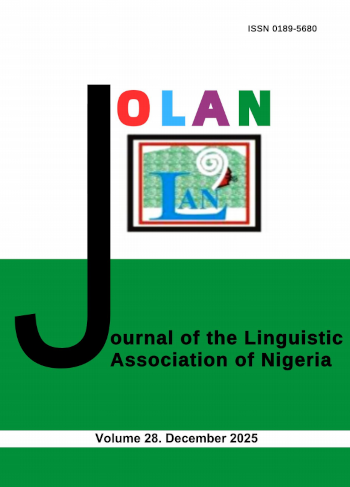Error Analysis of Yorùbá-English Subtitles in Nollywood Movies: The Case of Two Grammar Components
Keywords:
Error analysis, Nollywood, Yorùbá movies, Communication, Grammar, SubtitlesAbstract
This paper explores some selected Yorùbá movies with the aim of identifying and classifying errors committed in their subtitles. The focus is largely on morphosyntactic component of the target language (English). The study randomly selected four Yorùbá Nollywood movies. A total of sixty-six (66) structures were randomly transcribed from the screen. The study is carried out against the background of Government and Binding Theory. It is found that errors in translation/subtitling of Yorùbá Nollywood movies are becoming worse. M55ost of the sentences lack grammaticality. More specifically, Spec-Head Agreement, Extended Projection Principle and case filter, are the most flouted conditions. Also, most of the structures lack accurate morphological marking; the errors identified are duplication of (inflectional) morphological features, outright loss of inflection, and lack of agreement feature between items that require inflectional markings. This study predicts two implications of these errors. First, that there is a subtle threat to the industry; it may result to decline in home consumption of the production from the industry. Second, that the industry constitutes a threat to the learning of English among young viewers; some, especially children are likely to learn errors in the course of watching such movies. Lastly, non-Yorùbá viewers may erroneously consider Yorùbá to be a pro-drop language due to frequent omission of the nominative singular pronominal, I. Thus there is the need to respond quickly to this in order to salvage the situation. It is thus recommended that professional editors should be recruited into the production team for better performance.
References
Abbas, U. A. (2014). Code switching in Hausa films songs. Presented at the 1stInternational Conference On Endangered Languages In Nigeria, in Honour and Memory of Professor M. K. M. Galadanci Held on 4th – 5th August, 2014 at Bayero University, Kano.
Ahmed, U. & Daura, B. (1970). An introduction to classical Hausa and the major dialects. Zaria: Northern Nigeria Publishing Company, Limited.
Ariffin, K. & Rafik-Galea, S. (2009). Code-switching as a communication device in conversation. Language & Society, 5.
Auer, P. (2010). Code-switching / mixing. The SAGE handbook of sociolinguistics, 460.
Blom, J. P., & Gumperz, J. J. (1972). Social meaning in linguistic structures: Code-switching in Norway. Directions in sociolinguistics, 407-434.
Bollinger, D. (1975). Aspects of Language. New York: Harcourt Brace Jovanovich.
Bowers, D. L. (2006). Grammatical constraints and motivations for English / Afrikáans codeswitching: Evidence from a local radio talk show (Doctoral dissertation, University of the Western Cape).
Chamo, I. Y. (2012). Hausa–English code switching in Kanywood films. International Journal of Linguistics, 4(2), 87-96.
Essien, O. E. (2000). Code-switching and code-mixing in Nigeria, Kiabara Journal of Humanities, 6(2) 1-8
Fromkin, V. et al., (2011).An introduction to language. USA: Werdsworth language learning.
Gumperz, J. J. (1982). Discourse strategies. Cambridge: Cambridge University Press.
Hamers, J. F. & Blanc, H. A. (2000). Bilinguality and bilingualism. Cambridge: Cambridge University Press.
Holmes, J. (2013). An introduction to sociolinguistics. New York: Longman.
Inuwa, Y. N. (2014). Functions of Hausa-English code switching: A Sociolinguistic Investigation. M. A. Thesis (Universiti Utara Malaysia).
Inuwa, Y. N. (2014b). Manifestations of code switching within the spontaneous conversation of Hausa bilinguals. IJMRA- International Journal of Physical and Social Sciences, 4(5), p. 111-125.
Inuwa, Y. N. (2014c). Significance of Hausa-English code switching. Academic Research International, 5(3), p. 164-173.
Jagero, N. & Odongo, E. K. (2011). Patterns and motivations of code switching among male and female in different ranks and age groups in Nairobi, Kenya, International Journal of Linguistics, 3(1), E40.
Li, W. (2000). Dimension of bilingualism. The Bilingualism Reader, 3-25, London: Routledge.
Malik, L. (1994). Sociolinguistics: A study of code-switching, New Delhi: Anmol.
McCormick, K. (1995). Code-switching, code-mixing and convergence in Cape Town, in R. Mesthrie (ed.), Language and social history, Cape Town: David Philip Publishers, p. 193-208.
Milroy, L.,& Gordon, M. (2003).Sociolinguistics: Method and Interpretation. Oxford: Blackwell Publishing.
Muysken, P. (2000) Bilingual speech: A Typology of Code mixing, Cambridge: Cambridge University Press.
Obiamalu, G. O. & D. U. Mbagwu, (2007). Motivations for code switching among Igbo- English bilinguals: a linguistics and socio-psycholinguistics Survey, OGIRIS: A New Journal of African Studies, 5(1), 27 - 39.
Poplack, S. (1980). Sometimes I'll start a sentence in Spanish y termino en Español: Toward a typology of code-switching. Linguistics, 18, 581-618.
Romaine, S. (1995). Bilingualism. Oxford: Blackwell.
Sarvi, S. A. (2014). Code switching and code mixing as barriers to effective translation. Presented at the 1stInternational Conference On Endangered Languages In Nigeria, in Honour and Memory of Professor M. K. M. Galadanci Held on 4th – 5th August, 2014 at Bayero University, Kano.
Ugot, M. (2009). Language choice, code-switching, and code-mixing in Biase. Global Journal of Humanities, 8(2), 27-35.
Wardhaugh, R. (2011).An introduction to sociolinguistics. USA: Blackwell Publishing.
Weinreich, U. (1968).Language in Contact. Hague: Mouton.
Woolard, K. A. (2004).Code switching in Durante: A companion to linguistic Anthropology. Oxford: Blackwell.
Yusif, H. A. (1985). Syntax of Hausa-Arabic Code-switching: A Case Study of Intrasentential Analysis, in Studies in Hausa Language, Literature and Culture, CSNL, Kano: Bayero University.
Yusuf, M. A. (2011).Hausa Grammar: An Introduction. Zaria: Ahmadu Bello University Press.














